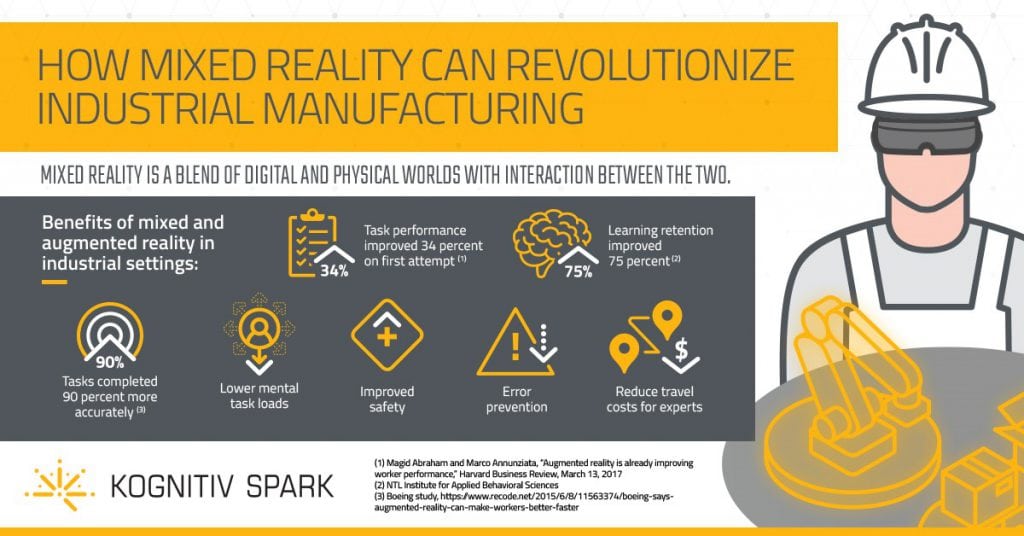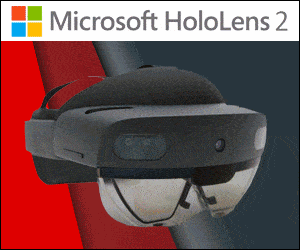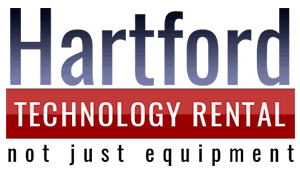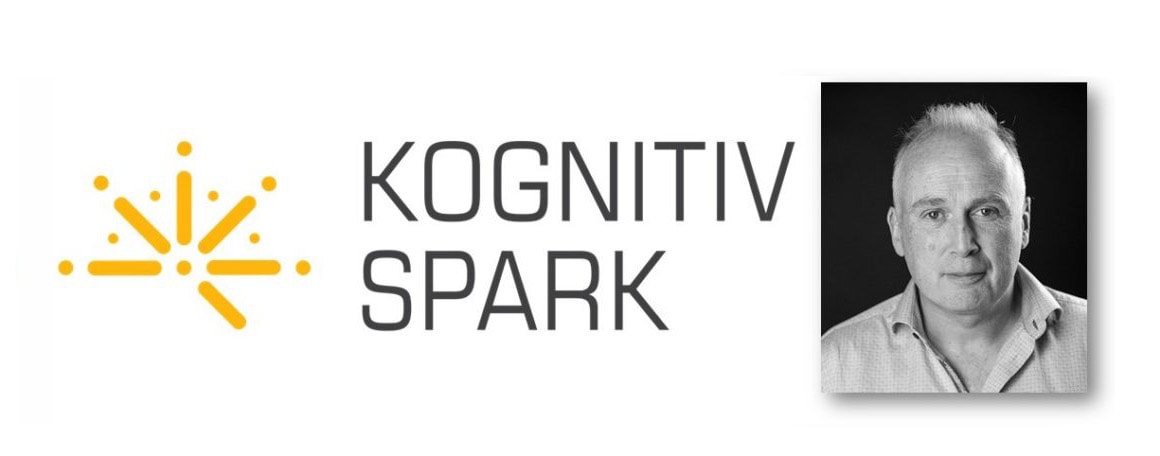In this blog post, we interview Duncan McSporran, Co-Founder and COO at Kognitiv Spark, who explains in his own words how the RemoteSpark software installed on the HoloLens 2 is transforming various manufacturing and industrial sectors.
Tell us about Kognitiv Spark
RemoteSpark is the principal software from Kognitiv Spark. It’s a remote worker assistance platform for the Microsoft HoloLens that’s focused on the end user who needs to complete a task that they don’t have the experience or knowledge to complete. They need another team member and data to support their decision making as they proceed with a repair or an assessment. RemoteSpark enables this remotely without the need for an expert resource to travel to the job site. It’s a very powerful tool in the Mixed Reality/Augmented Reality space which is becoming more and more prevalent across industries.
Currently, RemoteSpark is being used in a wide range of manufacturing and other industrial companies with the most emphasis currently being placed on energy and defense – these are particular industries where the product/process experts are typically located a significant distance away from the actual field service technicians. The pandemic has proven to make getting an expert out in the field especially challenging and potentially risky from a health safety perspective and sometimes impossible due to the current travel restrictions.
Making augmented and mixed reality work where the end user needs it to work, a very simple yet powerful phrase, captures the mission of RemoteSpark. It’s fine if a remote support technology works in an office or demo space but to be successful any product is designed to solve on-site problems whether that’s an oil rig, at sea or on the side of a highway by a piece of equipment. Kognitiv Spark’s focus is on ease of use and transparency for the user. When the user is tired, hungry, wet or under pressure they need to be able to put a system on to their head using the Microsoft HoloLens that doesn’t add burden to the way in which they do their work.
What is Kognitiv Spark’s origin story?
Situated in the Highlands of Scotland, two friends sat down at the base of Ben Nevis, the highest mountain in Britain, and had a conversation that would change both of their lives. Ryan Groom had just been released from an NDA with Microsoft. Previously, Groom had founded Microsoft’s first Gold Partner company for Cybersecurity in Canada when he first learned about the top-secret new product Microsoft was developing at the main campus in Redmond, Washington to create a genuine leap-ahead capability in computing. That product was the Microsoft HoloLens. Now that he was free to talk about the product, he and Duncan McSporran, with a background in innovation and security in the British Army, shared a whisky and created the vision of what would become one of the most leading edge, innovative tech companies developing applications for the HoloLens. They initially came up with 19 use cases for ways the HoloLens could be used to benefit end users, but it also was clear even at that early stage that any product would need to focus on security. Instead of trying to market a 2 dimensional system that was overlaid on a 3 dimensional platform, this would be a ground up, fresh approach to computing. Shortly after that conversation in 2017, Kognitiv Spark was founded.
How would you explain the differences between AR, MR and VR to manufacturers considering these technologies?
To fully understand the quantum leap happening in technology today it’s crucial to understand the differences between Augmented Reality, Mixed Reality and Virtual Reality. AR, MR and VR is really a spectrum of capabilities.
VR, virtual reality, has an incredibly important part to play in the future but it is a platform that is removed from the workplace. While it may reflect a workplace that someone is familiar with the individual is not interacting with their real-world environment. They are in an entirely virtual environment. VR does not generate the types of cognitive responses that an individual needs when they are on site. This is why the majority of industrial organizations working with VR are using this technological capability to facilitate immersive training modules. It helps workers build memories of particular processes.
AR, augmented reality, is where you are simply adding in simple information into the field of view of the individual in the work space. The user is in the real world and they have access to some digital data. This digital data is added into the real world through a headset or 2D interface like a phone or tablet. Prompts or workflows are added along with either visual or audio communication. This technology, much like mixed reality keeps the working in their real world environment while adding a layer of task-relevant digital assets or capabilities. This is why these two technological capabilities are more inline with performance augmentation and more operationally-focused use cases.
MR, mixed reality, is the forward leaning technology. Complete three-dimensional objects are overlaid on the reality in front of the user. This adds a powerful component of understanding how to do a task or solve a problem. All of the elements of AR are present with the addition of 3 dimensional objects that can be interacted with and occupy space in the field of view as if it’s a real object. This allows you to take the power of AR to the next level by helping the user to understand in three dimensions what it is they need to do or what it is they are looking at if they are not familiar with the systems. You can also add in animations…how does this complex system that I’m looking at go apart and come together. Instead of interpreting a PDF or instruction manual that you could provide physically or via AR, you now allow the brain to see exactly in 3 dimensional space how a step by step process works. This also removes misinterpretation via written instruction and eliminates cognitive and language barriers. On top of that you can add additional data like sensors or the internet of things to complete the picture.
Tell us about the technologies that Kognitiv Spark has developed to serve business
RemoteSpark is the name of the flagship software platform and where the company has had significant successes is with defense. Our biggest customer is the Canadian Department of National Defense. They saw the benefit of what we were doing at a very early stage and came to us and said “can you do this?” It was sort of an exploratory development. That led to being summoned to having a chat with the Commander of The Royal Canadian Navy. He mapped out his vision of where he thought the Canadian Navy was going to be. We were brought to this discussion because Microsoft had been asked the same question and said “No we can’t but we have a team in Canada that can.” As a result of that discussion, we built out a successful roadmap of where they are now, where they want to be in the next 12 months and where their long-term vision is. We were able to build a very strong partnership. We are not just about building the software. What we realized very early on was that this is so incredibly game changing. You can’t just use this the way that you use regular Microsoft software like PowerPoint or Word or Teams. What they were really looking for was a team that would collaborate with them by taking best practice, and help build the processes that would benefit the sailors in Canada’s Navy through impactful use of MR where they need it to work – at the job site.
We are laser focused on security and own every single line of code in our product. We did not use a third-party 3D rendering engine and we created our own from scratch. We also provide a solution that requires very low bandwidth condition to operate optimally. We have removed the dependencies as much as possible for the holograms so anyone can create them in an easy to use manner.
The best part about what we are doing is that we get introduced to partners like the Royal Canadian Navy and Hartford by Microsoft. For us to get that validation from the world’s largest technical IT company is enormously gratifying. When you are the technical partner of choice that is a demonstration that you are getting things right and not just a software vendor.
How is RemoteSpark helping with top line sales and bottom line efficiencies?

On the sales side, we are seeing the most success from demanding industrial companies. They really understand the benefits and return on investment, particularly in the maritime sector. Whether it’s how do we design a ship or how do we create real operational value on platforms. The other primary growth sector is defense industrial prime contractors. It’s interesting because while these contractors are not customers of ours we have still been able to work with them on collaborative projects and much of the work that they are doing, while proprietary, they were able to share with us. They clearly have validated the potential for growth and sale.
On the bottom line it’s the men and women in uniform and the front-line healthcare workers. They understand that this is a piece of equipment that is mission critical and they quickly grab hold of this new technology. Our biggest challenge with these types of customers is getting them to understand that this technology is not about replacing their jobs but is about increasing their efficiencies. We currently have Canadian Medics using the systems to validate the ability to create on the spot surgical applications. For instance a vascular surgeon is testing how to provide direct assistance to a trained medic in the field wherever they are in the world as long as they can achieve a connection of 128kb in their environment.
What aspects of the HoloLens 2 are helping to inspire innovation at Kognitiv Spark?
The HoloLens 2 is vastly more comfortable for the end user to wear for longer periods of time. Additionally, the field of view was increased dramatically. This meant that workers could more intuitively interact with the MR environment. When Microsoft was doing the final design they listened to suggestions. That listening nature that Microsoft brings on the product engineering side is absolutely essential and it fills us with an immense amount of positivity about where the future is going to go.
Who out there needs to know about Kognitiv Spark and how you can help them?
The automotive sector is an industry that is poised to significantly increase its adoption of the MR remote support software. Microsoft has had some success but the industry has not quite grasped how transformational the technology is going to be for them. From industrial design to manufacturing to delivery to customer orientation to service and maintenance all the way to decommissioning, the HoloLens 2 can help with a whole of life product management for the automobile industry. As we get to more complex, integrated electrified vehicles then HoloLens 2 becomes much more valuable tool. When the designers and engineers are located in California and the automobile is located across the country an MR solution on HoloLens 2 becomes a key component in product support across the entire spectrum of the vehicle’s life cycle.
Another industry that stands to benefit from MR is space. Mixed reality in space is a very niche area. We’re the only capability that works on premise, or in other words, disconnected from the internet with full mixed reality access. For us the biggest challenges are going to be the astronauts on the lunar gateway and they are not going to be able to wait for their call from mission control or JPL for support because of the latency in the satellites. We can create those mixed reality platforms to work on the lunar gateway or on the moon itself or on Mars or the International Space Station. We also see the HoloLens being used in the clean rooms when the satellites or other items are being engineered and manufactured. With the engineers located in a different country than the clean room, the package of RemoteSpark on the HoloLens 2 can become the defacto technical support device to support the technicians remotely.
How should manufacturers go about identifying the right use case to pilot RemoteSpark?
Get the HoloLens in to the hands of the operational teams or get the discussion going with the operational teams as early as possible. Don’t let the concerns about IT infrastructure prevent you from taking the first step.
A major aerospace manufacturer took RemoteSpark in to one of their largest facilities over the space of a week with their Continual Improvement Group as a supporting function of their operational team and within a week they had identified 240 use cases where RemoteSpark on the HoloLens 2 would return an impact. In situations like this the discussion becomes very sticky. There is no doubt in the minds of this group that mixed reality must be adopted over time.
By being an easy-to-use product that is ready to go right out of the box, RemoteSpark is dramatically changing the way business, innovation and support is happening. After about 45 minutes of use time, the Electrical Power Research Institute has documented that the system can be used on task to be guided through a job function.
Do end users need to already own or buy the HoloLens 2 to test RemoteSpark?
 Kognitiv Spark does not own any loaner or rental headsets. When a customer needs to have some additional headsets for a special project or needs to test a few prior to the implementation of a rollout, Kognitiv Spark refers the end-user to the Try Before You Buy Promotion from Hartford Technology Rentals. Hartford can ship all over the country and around the world so customers can place an order for multiple headsets going to multiple locations and count on them arriving on time, ready to go. With Hartford, you have an opportunity to “try before you buy.”
Kognitiv Spark does not own any loaner or rental headsets. When a customer needs to have some additional headsets for a special project or needs to test a few prior to the implementation of a rollout, Kognitiv Spark refers the end-user to the Try Before You Buy Promotion from Hartford Technology Rentals. Hartford can ship all over the country and around the world so customers can place an order for multiple headsets going to multiple locations and count on them arriving on time, ready to go. With Hartford, you have an opportunity to “try before you buy.”
What is Kognitiv Spark focusing on right now?
The continued focus today is ease of access. It’s making sure that there are no obstacles to adoption or as few obstacles as possible. We reduce dependency on elaborate systems and support. You don’t need high bandwidth, which is manifest in that we have users that operate with 128KB bandwidth. As a further step to ease access and get the right support to the end-user, an expert can do a call on RemoteSpark from a browser. The person with the headset can send an invite from the headset to anybody and get help immediately. That functionality comes with some reduced features but that concept of immediacy or instant assistance is another key feature that end users appreciate and use regularly. All that being said by reducing the bandwidth requirements and dependency on complex architecture we also increase the security of the headset.
How will AR/MR/VR transform business in the future?
We think that the future is going to blow people’s minds. We’re working closely with Microsoft and maximizing the functionality that is built in to the headsets in a way that no one else is currently doing. Most of these changes will address how we deal with the focus on worker support to visualization and increasingly to situational awareness. How is all the data that is available going to be presented to the user? How do you transfer the knowledge that an expert has and make it accessible to a novice who is just starting their career? When the silver tsunami starts to retire how do you take decades of collective knowledge and experience and make it available to the apprentice who is just beginning?
How can users contact Kognitiv Spark to learn more?
To learn more about Kognitiv Spark and RemoteSpark you can click the link or:
Call: 877-374-6818
Email: hello@kognitivspark.com
To contact Hartford Technology Rental and arrange the rental of the Microsoft HoloLens 2 please call us at 888-520-5667.


